NS0-603 Online Practice Questions and Answers
You are sizing a new Azure NetApp Flies deployment and are documenting the throughput limit calculations within the design. In this scenario, which two factors are used to accomplish this task? (Choose two.)
A. the quota that is assigned to the capacity pool
B. the service level of the capacity pool
C. the service level of the volume
D. the quota that is assigned to the volume
You are asked to develop a migration strategy for your customer that is migrating several SMB and NFS workloads from on-premises to Azure NetApp Files. In this scenario, which three technologies should you consider? (Choose three.)
A. rsync
B. robocopy
C. NetApp Cloud Sync service
D. Azure Storage Explorer
E. SnapMirror technology
Exhibit.

Which deployment model for NetApp Cloud Volumes ONTAP in AWS would use the networking topology as shown in the exhibit?
A. single node, multiple availability zones
B. HA nodes, single availability zone
C. single node, single availability zone
D. HA nodes, multiple availability zone
You are using Windows Virtual Desktops and storing user profiles on Azure NetApp Files by using the Premium storage service level. There will be 1000 contractors coming onboard for a short duration to assist with project work, and each one of them requires virtual desktop access.
In this scenario, which three actions address the short term performance demand without affecting the latency of existing users? (Choose three.)
A. Use FlexCache.
B. Increase the volume quota on Azure NetApp Files.
C. Change the Azure NetApp Files service level to Ultra Storage.
D. Increase the capacity pool on Azure NetApp Files.
E. Enable encryption on Azure NetApp Files.
You are designing a solution using NetApp Cloud Tiering and want to Include details for the user on how to monitor network latency and throughput, so that they can identify potential bottlenecks that could affect the tiering service.
In this scenario, which tool would you include in the design to complete this task?
A. Inactive Data Reporting
B. Amazon CloudWatch
C. NetApp Cloud Manager
D. NetApp XCP
Which NetApp Cloud Manager feature would be enabled to support Immutability of the data?
A. NetApp Cloud WORM
B. NetApp Storage Encryption
C. NetApp Snapshot
D. NetApp Volume Encryption
Your customer wants to move from hosting all workloads in a public cloud to infrastructure- as-a-service (IaaS) on-premises.
In this scenario, which two benefits would you present to the customer? (Choose two.)
A. scalability
B. data sovereignty
C. agility
D. data security
You must configure data replication between a NetApp Cloud Volumes ONTAP system in AWS and a
In this scenario, what is a cost-effective way to accomplish this goal?
A. Set up an Internet gateway on the AWS VPC that is hosting the Cloud Volumes ONTAP instance.
B. You must configure ExpressRoute and Direct Connect with your on-premises data center.
C. You must allow NetApp Cloud Manager to configure the network communication between the working environments during the cluster peering setup wizard.
D. You must configure a VPN connection between the AWS VPC and the Azure VNet.
You are designing a highly available solution based on NetApp Cloud Volumes ONTAP that will be deployed in Google Cloud. The solution will need to grow over time to meet demand.
In this scenario, when adding disks, which two statements are true? (Choose two.)
A. Cloud Manager creates a mirrored aggregate.
B. Cloud Manager adds a new Cloud Volumes ONTAP instance.
C. Cloud Manager allocates disks to both nodes.
D. Cloud Manager allocates disks to one node.
You must consolidate your branch office Microsoft Windows file servers Into the cloud with the objective to centralize ail Microsoft Windows file shares (SMB) into your Active Directory domain. After analyzing your unstructured data set, you find that 10% of the data Is active and 90% of your data is archive data. You deploy NetApp Cloud Volumes ONTAP in Microsoft Azure and enable data tiering to tier off data to object storage, leaving all the defaults for the capacity tier.
In this scenario, by default, which storage class is used for your archive data?
A. nearline storage class
B. cool storage tier
C. hot tier
D. coldline storage class
You must identify cold data before enabling FabricPool technology with NetApp ONTAP 9.8 software In this scenario, which NetApp feature or tool would you, use ,to accomplish this task?
A. XCP File Analytics
B. Inactive Data Reporting
C. SnapMirror
D. Harvest
An administrator notices that disks need to be added to Increase capacity in NetApp Cloud Volumes ONTAP in Azure deployed as an HA pair. The administrator is preparing to use the Azure portal to add the disks.
As a cloud architect, what would you tell the administrator to do in this situation?
A. Use NetApp System Manager to log into Cloud Volumes ONTAP and add disks to the right node.
B. Use NetApp Cloud Manager to add disks to the aggregate.
C. Use the CLI to log into Cloud Volumes ONTAP and add disks to the right node.
D. Use the Azure portal to navigate to the storage account and add a new Blob container.
You are designing a cloud storage solution for a customer in Microsoft Azure with strict security requirements. They want to use Azure NetApp Files and they require "krb5p" for all NFS traffic. The workload is highly concurrent and mostly sequential.
In this scenario, how will throughput be affected?
A. Throughput will be significantly decrease
B. Throughput will be slightly increased.
C. Throughput will not be affected.
D. Throughput will be slightly decreased.
Your customer wants to demonstrate data privacy compliance by monitoring as many platforms as possible across on-premises and the public cloud with NetApp Cloud Data Sense (formerly Cloud Compliance). In this scenario, which two data sources are supported? (Choose two.)
A. Microsoft Exchange
B. Oracle Database
C. Amazon S3
D. DB2
Exhibit.

You are designing a NetApp Cloud Backup solution for your on-premises ONTAP clusters to Azure Blob storage. Referring to the exhibit, which two statements are true? (Choose two.)
A. An inbound connection is required from the Connector.
B. A connection between the cluster and the Cloud Backup service is not required.
C. An outbound connection is required to the Connector.
D. A connection between the cluster and the Cloud Backup service is required.
